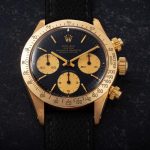By now, loyal Hodinkee readers will know that I like big shiny things. The more gemstones I can marvel at during the trade show, the more at peace I feel. Playing with diamonds is my form of escapism; I transcend into another realm, my mind basically leaves my body and for a few minutes, and all that matters is light-play.
But I fail to understand why liking diamonds on perfect replica watches seems to signify a lack of taste for a certain contingent of the watch community. I’m hoping the TAG Heuer Plasma can help build a case for why gem setting on watches is just so undervalued. And how, in this particular instance, the gem-setting is proof of serious scientific innovation.
Last year TAG Heuer released its first Carrera Plasma and the 44mm tourbillon model was a huge highlight of the trade show. In fact, there were a number of times that I passed by the booth to get a second peek at the UK best fake watches inside of its very important glass case, and 90% of the time it was nowhere to be found. It was so elusive that I wondered if it was a ploy to keep us coming back for more; like a new love interest who texts you back so sporadically that even a “hey how r u” text feels like a declaration of love.
After my last Plasma sighting in 2022, I spent a good portion of the year brushing up on my lab-grown diamond knowledge. It’s a polarizing topic in the jewelry world and, rather inevitably, there are a lot of politics tied up in a debate concerning the $84 billion dollar “natural” diamond industry.
But if you want to look at the facts then it’s pretty simple. Scientists can now make gemstones in a laboratory that are structurally identical to diamonds mined from the earth.
The first generation of Plasma released last year was priced at 350,000 CHF – that’s big bucks for TAG Heuer. The high quality replica watches incorporated unique cutting and a very creative approach to the actual gem setting. The major developments were a solid diamond crown and single piece dial thanks to the totally unique polycrystalline structure of the diamond: A single piece of diamond created from multiple crystals that have been grown together achieved using the CVD process.
There are two ways of growing gems in a lab: HPHT (High-pressure high temperature) which replicates the natural heat and pressure settings of the earth’s crust and CVD (chemical vapor deposition), growing the diamond atom by atom which gives a lot more control over the size of the diamond being created. “The great power of CVD is that you can produce stones much closer to spec and therefore reduce wastage and create a much lower electrical footprint,” explained TAG Heuer heritage director Nicholas Biebuyck.
The updates to the 1:1 online fake TAG Heuer Carrera Plasma tourbillon watches include an aluminum bracelet with gem-setting that extends beyond the case and onto the bracelet as well as additional diamonds on the bezel. TAG Heuer has partnered with Geneva-based company Salanitro – a leader in the gem-setting world that is frequently called on by high-end watchmakers, including Patek Philippe – for various parts of the cutting and mounting process but the unique single-stone diamond crown is cut, mounted, and bonded in-house.
There is now also a totally brand new model in the Plasma family: The Carrera Plasma Diamant d’Avant-Garde which uses a 36mm Carrera case as the foundation. This Swiss made super clone watches features even more technology than its predecessor, as the crown and shield decoration on the dial are made with colored (soft baby pink to be specific) diamonds, another first for the watch industry. “None of these colored stones are treated, the color is in the stone, it’s all done within the CVD process,” Biebuyck remarked. Cheap TAG Heuer replica watches is actually using a new Swiss-based supplier for these colored stones, an interesting fact considering this kind of technology is still extremely niche and suppliers are few and far between with the biggest known currently based in Israel and the USA.
Lab-grown diamonds are changing an entire consumer landscape by democratizing the cost of a highly guarded jewelry industry, providing newfound flexibility in design, and helping to provide a very necessary reduction in wastage. TAG Heuer was the first luxury Swiss watchmaker to integrate lab-grown diamonds into their commercial product and LVMH Luxury Ventures, (along with other key investors), completed a $90 million investment round in Israeli-based company Lusix, a leader in the lab-grown diamond industry. Clearly LVMH are looking to forge a solid path in the lab grown space. Perhaps this an attempt at luxury with an eye toward longevity? It’s certainly an attempt at keeping up with technology and the mindset of a future, much younger luxury consumer base.
No matter which side of the fence you’re on when it comes to the lab-grown argument, or whether you’re paying even the slightest bit of attention to the jewelry industry’s most contentious debate (well one, we love to argue) if LVMH is producing CVD stones, chances are we need to sit up and take note. Top TAG Heuer copy watches is so far ahead of the curve on this one. And I am truly curious to see how this pans out over the next few years.





